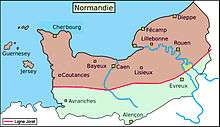Joret line

The Joret line (French ligne Joret) is an isogloss used in the linguistics of the langues d'oïl. Dialects north of the line have preserved Vulgar Latin /k/ and /ɡ/ before /a/; dialects south of the line have palatalized /k/ and /ɡ/ before /a/. This palatalization gave Old French /tʃ/ and /dʒ/, then modern French /ʃ/ and /ʒ/. The line was first identified by Charles Joret and published in 1883.
To the north of the line lie the Picard language and some dialects of the Norman language. To the south and the east lie other Oïl dialects including southern Norman and French. The area north of the ligne Joret is sometimes called the Normano-Picard domain.
Geography
The Joret line extends from the Channel Islands (including Jèrriais, Guernésiais and Sercquiais) and across the continent from Granville, Manche to the linguistic border with the Dutch language in the North of France and Belgium.[1] It passes through Normandy north of Granville and Villedieu-les-Poêles and divides Manche in two linguistically and separates Calvados and Orne along with Eure.
In Picardy, the line runs with the Amiénois and Thiérache, up to the west of Rebecq, Beaumont and Chimay in Belgium.
Examples
- Norman Picard /k/ ~ Southern Norman, French /ʃ/ (palatalization)
- Latin cattu (cat) gave rise to /ka/ cat north of the line and /ʃa/ chat to the south.
- Low Latin *captiare (to catch) gave rise to cachier / cacher (> English catch) north of the line and chasser (> English chase) to the south.
- Frankish *pokka (bag) gave rise to /puk/ pouque (> English dial. poke) north of the line and pouche (> English pouch) to the south. French poche (pocket), Norman pouquette (> English pocket).
- Latin candela (candle) gave rise to candelle north of the line and chandelle to the south.
- Celtic *carros > Latin carrus gave rise to car (> English car) north of the line and char (wain, carriage), chariot (> English chariot) to the south.
- Celtic *kagio-, Gaulish caio- > Norman Picard kay, cay (> ME kay) > French quai (> English quay); Old French chay > French chai (wine cellar)
- Norman Picard /ɡ/ ~ Southern Norman, French /ʒ/ (palatalization)
- Latin gamba (leg) gave rise to /ɡãb/ gambe north of the line and /ʒãb/ jambe to the south.
- Frankish *gard- (yard) gave rise to gardin (> English garden) north of the line and jardin to the south.
- Late Latin *galleto > Norman Picard gal(l)on (> English gallon) ; Old French jallon , French jalon (measure)
Second isogloss
Another effect of the palatalizations a bit further to the north but quite parallel was this:
- Norman Picard /ʃ/ (or /tʃ/) ~ Southern Norman /ts/ or /s/, French /s/.
- Low Latin *captiare > Norman Picard cacher, cachi(er) (> English catch); Southern Norman, French chasser
- Low Latin ceresiu(m) > Norman Picard cherise, chrise, chise (> English cherry); Southern Norman srise French cerise
Third isogloss
A third isogloss, marking a consonantal change unrelated to the others, more or less follows the Joret line throughout Normandy and continues through northeastern France. It includes all of Picardy, Wallonia, Champagne, Lorraine and a part of Burgundy.
Germanic /w/ (sometimes Latin /v/ was affected as well) was kept north of the line (written w or v), but became /g/ (written g or gu) south of the line.
- Northern French /v/ ~ French /g/
- Latin vespa / Frankish *waspa (wasp) > Picard Wespe, Norman Vêpe ~ French guêpe (wasp)
- Frankish *wahla hlaupan (S. English well and leap) > Picard, Old Norman waloper (> English wallop) ; French galoper (> English gallop)
- Frankish wahtôn (S. English wake and watch) > Picard Old Norman wait(i)er (> English wait) ; Old French guaitier, French guetter
- Frankish *werra > Old Picard Old Norman werre, warre (> English war) ; French guerre (war)
Toponymy
The Joret line affects toponyms in Normandy and Picardy ; for example : Cambrai (corresponding to Chambray), Camembert, Carentan (corresponding to Charenton), Caen (Wace gallicized as Chaem).
Norman place-names derived from the Gallo-Romance word Campaniacum show initial C- in some cases (Campigny, north) and initial Ch- in others (Champigny-la-Futelaye, south).
See also
References
- La Normandie dialectale Lepelley, Caen 1999 ISBN 2-84133-076-1